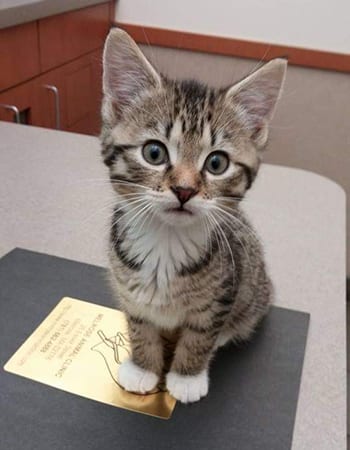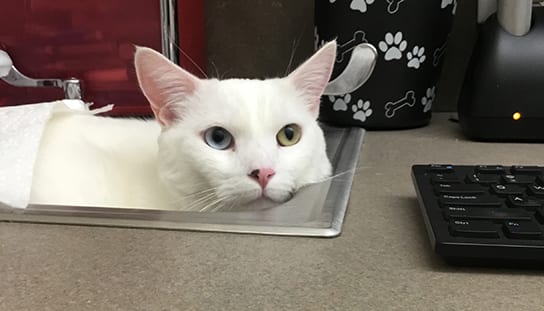NEW KITTEN PACK: WHAT TO EXPECT
The veterinarians at Melrose Animal Clinic are happy to help you make the best call for you and your pet.

Physical examination: An important part of your pet's wellness. We will examine the eyes, ears, mouth, and teeth, as well as the coat, skin, and general muscular condition. We will feel the internal organs and listen to the heart and lungs. We will also weigh your pet and discuss with you its overall condition.
Fecal Examination: The fecal (stool) examination is a laboratory test that checks your pet for the presence of intestinal parasites, which is very common in kittens. These parasites can cause serious gastrointestinal upset resulting in vomiting and or diarrhea. They are also potentially contagious to humans.
Vaccinations:
- Core vaccinations include Rabies (once a year) and HCP/Distemper (given at 6-8 weeks of age, repeated every 3-4 weeks until 16 weeks of age).
- Lifestyle Vaccinations include Feline Leukemia if your pet goes outside. Vaccine is given in two doses 3-4 weeks apart.
- For the full list of vaccinations for your kitten, visit our Vaccinations page.
Feline Leukemia & Feline Immunodeficiency Screening: FeLV/FIV are viruses that can be transmitted between cats and from your kitten’s parents to your kitten. It is recommended that your kitten be screened for these viruses prior to being introduced to other cats and ideally retested at 6 months of age to ensure no false positive or negative tests.
During your kitten's first visit we will also cover options for a microchip, flea/tick prevention, at-home dental care, spay/neutering, and insurance.
SPAYING & NEUTERING
Our veterinarians recommend spaying female and neutering male cats at the ages of 5-6 months of age. The doctor will discuss in detail the medical and behavioral benefits of the procedure for your pet.
Neutering: It reduces kitten overpopulation, the spread of infectious diseases, and aggression toward other animals. It also eliminates the desire to seek out female cats.
Spaying: Eliminates estrous (heat)-- no bloody discharge, ranting pacing/crying. Reduces risk for mammary cancer. Eliminates risk of life-threatening infection of the uterus and decreases the desire to roam in search of a mate.
Litter Box Training: Chances are, your kitten is already trained
Cats are instinctively drawn to “go” in litter-like areas, so chances are; your kitten is already trained. All you need to do is introduce them to the box. Being prepared with the right supplies is important. Help your kitten get used to its new home by keeping them in one room for a couple of days. Below is a helpful Q&A.
What kind of box should I buy?
The style is up to your kitten’s personality. A hooded version works well for cats who crave privacy, but it can leave others feeling boxed in. You don’t want the litter (or its contents) to fly overboard, so go with a box with enough room for your cat to move around in. If you have a kitten, choose a box she can get into-and grow into easily.
Where should I put the box?
Potty time is a private affair for most cats, so pick a quiet place that’s free of chaos and obstacles. To make it easy it is recommended to have a box on each level of your home.
How much litter goes in there?
Usually you want your cat to dig it. Definitely check the package for specifics, but about two to three inches for non-clumping and three to four inches for clumping.
How do I keep it clean?
Be sure to scoop waste daily and change the litter at least as often as the package suggests. Change the litter at least as often as the package suggest. Bag the old litter and toss in the trash – don’t flush (even flushable types can wreak havoc on your plumbing).

TIPS FOR CLIPPING YOUR PET'S TOENAILS
Toenails are naturally curved. If they are not trimmed they can and will grow all the way around into the paw pad. An untrimmed dewclaw can easily get caught on something and cause injury.
*Your pet’s toenails are too long if they click on the floor!
*Sometimes with regular clipping, you will eventually cut a nail too short and the vein (quick) will bleed. Apply Kwik stop (you can purchase this at any pet store) into the bleeding nail until the bleeding subsides. You might have to apply this more than once.

Step-By-Step to Clip Nails:
Get your pet used to having all 4 paws handled. Spread the toes and gently pull on each nail. Familiarize him/her with the clippers by letting your pet sniff it, mouth it and gently rub it on their feet.
Look at and feel the underneath side of the nail. It will feel solid until you get close to the end-where you will then feel a hollow curved tip. The tip is past the quick and can be safely clipped off.
You must hold the paw steady, but holding too tightly will cause your pet to pull the paw away from you. Hold the paw between your first two fingers, place the third finger on the pad of one toe and press gently with your thumb on top. This will push the nail out and in a good position for clipping. Be careful with long-haired breeds and that fur does not get caught in the clipper. Clip quickly and at a slight angle away from you, just below where the nail curves/bends.
Common feline toxins to be aware of:
Following are the 10 categories of potentially deadly substances found in or near the home that are most frequently asked about by callers to the ASPCA center:
- Human medications and food
- Insecticides, rodenticides, and gardening products
- Indoor and outdoor plants
- Veterinary medications (non-feline/allergies)
- Household cleaners and chemical hazards
- Heavy metals
*Click here for emergency information. ASPCA Animal Poison Control 1-888-426-4435.
